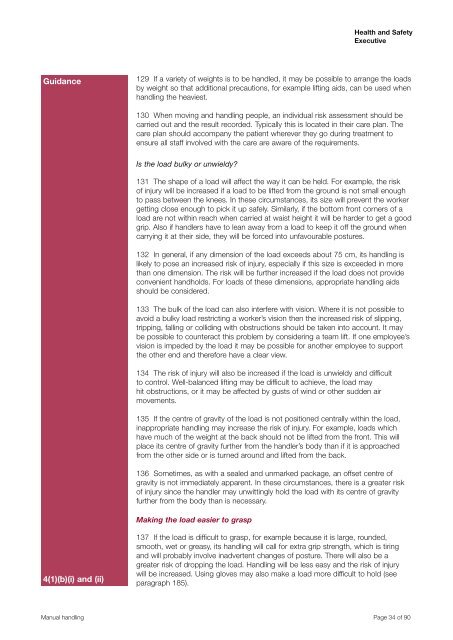Manual Handling Manual Handling Operations Regulations 1992 ...
Manual Handling Manual Handling Operations Regulations 1992 ...
Manual Handling Manual Handling Operations Regulations 1992 ...
Create successful ePaper yourself
Turn your PDF publications into a flip-book with our unique Google optimized e-Paper software.
Health and Safety<br />
Executive<br />
Guidance<br />
129 If a variety of weights is to be handled, it may be possible to arrange the loads<br />
by weight so that additional precautions, for example lifting aids, can be used when<br />
handling the heaviest.<br />
130 When moving and handling people, an individual risk assessment should be<br />
carried out and the result recorded. Typically this is located in their care plan. The<br />
care plan should accompany the patient wherever they go during treatment to<br />
ensure all staff involved with the care are aware of the requirements.<br />
Is the load bulky or unwieldy?<br />
131 The shape of a load will affect the way it can be held. For example, the risk<br />
of injury will be increased if a load to be lifted from the ground is not small enough<br />
to pass between the knees. In these circumstances, its size will prevent the worker<br />
getting close enough to pick it up safely. Similarly, if the bottom front corners of a<br />
load are not within reach when carried at waist height it will be harder to get a good<br />
grip. Also if handlers have to lean away from a load to keep it off the ground when<br />
carrying it at their side, they will be forced into unfavourable postures.<br />
132 In general, if any dimension of the load exceeds about 75 cm, its handling is<br />
likely to pose an increased risk of injury, especially if this size is exceeded in more<br />
than one dimension. The risk will be further increased if the load does not provide<br />
convenient handholds. For loads of these dimensions, appropriate handling aids<br />
should be considered.<br />
133 The bulk of the load can also interfere with vision. Where it is not possible to<br />
avoid a bulky load restricting a worker’s vision then the increased risk of slipping,<br />
tripping, falling or colliding with obstructions should be taken into account. It may<br />
be possible to counteract this problem by considering a team lift. If one employee’s<br />
vision is impeded by the load it may be possible for another employee to support<br />
the other end and therefore have a clear view.<br />
134 The risk of injury will also be increased if the load is unwieldy and difficult<br />
to control. Well-balanced lifting may be difficult to achieve, the load may<br />
hit obstructions, or it may be affected by gusts of wind or other sudden air<br />
movements.<br />
135 If the centre of gravity of the load is not positioned centrally within the load,<br />
inappropriate handling may increase the risk of injury. For example, loads which<br />
have much of the weight at the back should not be lifted from the front. This will<br />
place its centre of gravity further from the handler’s body than if it is approached<br />
from the other side or is turned around and lifted from the back.<br />
136 Sometimes, as with a sealed and unmarked package, an offset centre of<br />
gravity is not immediately apparent. In these circumstances, there is a greater risk<br />
of injury since the handler may unwittingly hold the load with its centre of gravity<br />
further from the body than is necessary.<br />
Making the load easier to grasp<br />
4(1)(b)(i) and (ii)<br />
137 If the load is difficult to grasp, for example because it is large, rounded,<br />
smooth, wet or greasy, its handling will call for extra grip strength, which is tiring<br />
and will probably involve inadvertent changes of posture. There will also be a<br />
greater risk of dropping the load. <strong>Handling</strong> will be less easy and the risk of injury<br />
will be increased. Using gloves may also make a load more difficult to hold (see<br />
paragraph 185).<br />
<strong>Manual</strong> handling Page 34 of 90
















